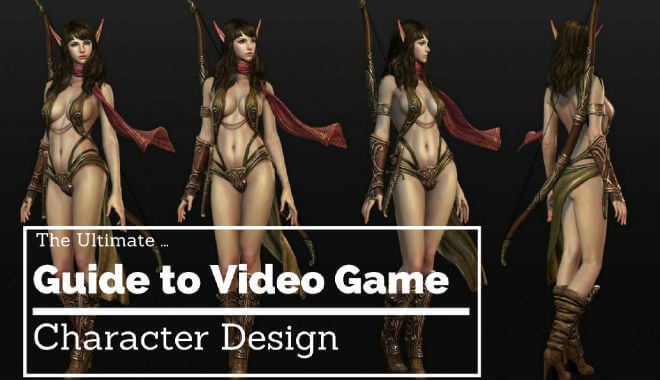
Everyone has one…
Do you know what we’re talking about? Favorite characters, of course!
Everyone has a favorite video game character, whether they admit it or not.
You can ask just about anyone what their favorite video game character is, and they’ll have an answer for you. They don’t even have to be avid gamers.
Some characters are so great that they transcend the video game barrier.
Your parents probably know about Zelda (or Link, if they really know their stuff) and Pikachu. Heck, even your grandparents probably know about Mario.
How to Design Awesome Game Characters?
What’s the trick to making characters stick?
How do you create characters that will resonate with people?
There is nothing more fun than creating a character and determining how that certain character will act in any given situation. It harkens back to older games like Dungeons & Dragons, where imagination and creativity are key.
My high elf, Florian, is a dandy highwayman who enjoys reading up on history and being an investigator. Not to mention, he’s a crack shot with a crossbow.
How can I bring Florian with me through different games? Well, good character design is responsible for this. IF Florian is truly as robust a character as I think he is, he can find himself manifested in nearly any game with character creation.
Designing characters in video games is one of the best ways to take a stock character and make it our own, creatively whittling down the more generic or default options, bringing a flavor of our own to the game world.
When certain games allow for in-depth character creation, it allows us to construct parts of our creativity on an otherwise boring or lackluster character.
We all love a protagonist in which we identify with. Games like The Legend of Zelda and Half-Life attempt to do this by transferring our emotions and reactions to their voiceless protagonists. It works wonders, but I’m more of a ‘create from scratch’ type of creator.
Although I respect icons of gaming like Link and Gordon Freeman, I would love to create my go-to elvish rogue, Florian in role-playing games rather than a prebuilt character.
Designing characters can be a large part of the fun. Even aspects of Grand Theft Auto: San Andreas, in which you add on to the appearance of the protagonist, C.J., are great little features that kept me coming back for me.
Following character design tips, you should have a better idea of what to create, how to create it, and how to go about playing that particular character in the specific game world.
Playing as our barbarian character who always swore to dispatch evil characters doesn’t even necessarily apply to sword and sorcery type of role-playing games.
In Fallout, you could be a similar build, hellbent on destroying the Enclave or super mutants. Who is the Maghda of which particular game you are playing?
In Dragon Age: Origins, it may be one of the various darkspawn or Arch Demon. Good character design translates to multiple worlds, universes, and games.
Vague Character Outline
When it comes to character design, one does not simply dive in. It’s important to plan exactly what you want out of your character. This is a daunting task, so a good place to start is with your character’s general nature.
Is your character a heroic, morally righteous person? Is she a gunslinger? Is he a cunning rogue? A smelly trickster? A fiendish creature? This archetypal play can help you define some parameters and focus your brainstorm.
Once you know, very generally, what you want your character to be, you can move on to the backstory.
Creating a Character Back Story
The backstory is important to a character. It will inform the character’s actions, and provide the character with motivations.
Every experience is subjective and inherently different. Even if two people experience the same event, they will process it differently, it will impact them differently.
The reason we’re so different, even from our brothers and sisters, is because our path of sensory input from birth to the present is completely unique.
Everything you’ve processed since you popped out of the womb has been processed through your unique perspective, digested by your one-of-a-kind neural pathways.
The effects of this are compounding, and not for the scope of this article. But, it should serve to illustrate the importance behind a fleshed-out backstory. Don’t be afraid to get a little crazy with your backstory depth.
Defining Your Video Game Character
This part can be challenging. In order to resonate with the audience, the character should come from an authentic place. That means you’ll have to really dive into this guy and figure out what makes him tick. Why does he do what he does?
Yes, we have the backstory. That’s a great start for motivations. But there’s more to think about. For example: Does your character ever tell a lie? What would he lie about? To whom?
People don’t act without reason, and neither should your character. Arbitrarily assigning backstory points and character traits won’t make for a good character. It’s important to ground your character’s decision-making and action-taking in reality.
Researching and understanding how (and why) people react in situations is a powerful character development tool.
Add Subtle Touches to Your Character
There are subtle ways to bring depth to your character.
There is a difference between a middle-aged man, well-dressed, with his music playing and a middle-aged man, well-dressed, who always has jazz on in the background.
This distinction might not show through in the game, i.e. you might not actually have the character ever listen to jazz.
But you know he likes it. You know he would stop and tap his foot if he heard jazz coming from a bar when he walked down the street.
It’s that kind of knowledge of detail that informs your character’s actions in a deeper way. It’s those depths and complexities that add up to really make a character stand out.
Your backstory and your deep-dive into the psychology of the character will also inform the character’s relationships with other characters.
One example of character interaction we found particularly satisfying took place in Diablo III. Playing as a barbarian, nothing was quite as gratifying as our interactions with Maghda.
It didn’t matter whether she had the upper hand or how bleak things looked. Our barbarian always promised to cleave her head from her shoulders.
As the player, you feel that.
You see the nephilim’s unrelenting spirit. You recognize how completely sure of success your character is.
Character Visual Appeal
Ok, so you’ve mapped out just about all there is to know about your character.
We know what wakes her up in the morning. We know what lets her sleep at night. And we know why she eats what she eats each day for lunch.
From that, we determine how she looks. We can use archetypes to determine a loose starting point for your character’s appearance.
Tanks are beefy and look like they can take some damage, rogues are lithe and darkly dressed. Healers embrace robes and radiate golden auras.
In every step of the visual stage, you need to make sure you’re capturing the essence of the character.
In Overwatch, every character has a totally unique appearance but still manages to fit within an archetype. Each character has a distinct personality and psychology.
If you’re familiar with the game, you know that McCree, Reaper, and Soldier 76 are all gunmen. Despite being male, offensive heroes that use guns, they are completely distinguishable.
The dangerous charm from McCree is very different from both the gristled badassery from Soldier 76 and the insidious lethality of Reaper.
Not only are these characters completely distinct from each other, but their personality, appearance, and overall design also inform the players of how they should be played.
Overwatch is a great example of how to create impressively distinct characters with archetypes as inspiration.
Games With Good Character Creation
Games with good character creation should be cherished, as they let us fulfill our gaming dreams. These games have fulfilled all of the necessary criteria for good character design.
Dragon’s Dogma
This gem of a role-playing game has some of my favorite game features. In it, you are the ‘Arisen’, the only being who can defeat a dragon that is terrorizing the world. Pretty standard RPG story, but still solid.
However, where Dragon’s Dogma really shines is character design. Dragon’s Dogma almost overwhelms the player with a huge number of options for customization. You can customize posture, leg size, torso thickness, and multiple eye colors.
And that is only scratching the surface! I swear, I spent more time designing characters in Dragon’s Dogma than I did playing other games. Dragon’s Dogma’s character designer allows you to dive into the story as your very own, unique person…and it works. Big beefy tanks, small elven rogues, it’s all here, folks.
Fallout 4
Character design has been a staple in the Fallout series of role-playing games since the series’ beginnings in the 1990s. The release of Fallout 4 in 2015 allowed players to go a step further than designing just the player character.
The game takes place before the bombs drop, and you need to sculpt your all-American family out of your imagination. Are you playing as a man or a woman? Can’t decide? Why not design both characters to see which you like better?
You can zero in on specific features of your character’s face, hair, eyes, and more. You can meticulously whittle down features, making this character pretty much whatever you want them to look like. This is a good character design.
Why?
Because the choices you make in customization alone have a deep impact later on in the game, but those are spoilers for another list.
Monster Hunter: World
Along with being an insanely fun game, Monster Hunter: World has a solid character creator. What you see is what you get here, which means there’s no deception. Deception?
Okay, let me explain.
In The Elder Scrolls IV: Oblivion, I spent a long time, (longer than I would like to admit), creating my ideal dark elf character. I didn’t hold anything back: my elf, Garrett, would have raven-black hair, wrinkly skin, piercing red eyes, and more.
However, as soon as I exited the dungeon, the lighting of the outside world didn’t help Garrett’s appearance at all. He looked like he had been a bloated body found in a river. I felt so betrayed!
Anyway, Monster Hunter doesn’t pull any fast ones like that. Your cool fantasy character has a respectable bunch of options for some rugged, extravagant, and exciting character design.
This is an example of how having a ton of options doesn’t necessarily make the game designer ‘good’.
It’s about implementation and seamless integration. No deception, just good-looking characters.
Dragon Age: Origins
Okay, so I know that maybe the newer Dragon Age game has a prettier character design, but I believe Origins is where the franchise gets off to a fantastic start.
When it came out in 2009, Origins maybe wasn’t the most graphically powerful game out there, but it made up for stunning visuals with amazing depth and lore. This translated into a fantastic character creator.
Designing characters felt like there were stakes to it, well before the tutorial mission even started.
In my first playthrough, I was playing as a noble human. Would my human noble, of House Cousland, be roguish? Charming? Slovenly? Slack-jawed and dumb?
The character creator adds aspects of the story in the creator, allowing you to preemptively get an idea of how your character would act within the world.
This is where I applied our principle of ‘going vague’, or mapping out the general nature of my character. Then the brilliant tutorial missions take place, and you can further your character’s background.
My human noble was humble, kind, and swore to get revenge for the evil baron who betrayed my parents but would ultimately show mercy, as it isn’t in his nature to kill unprovoked.
Instead, my character would pursue more legal action, locking up the baron rather than killing him. It is these little details that help Dragon Age: Origin’s character design goes from ‘stock RPG’ to ‘story-driven’.
It’s what we talked about before with the ‘subtle element’. How would your character act in a given situation?
Black Desert Online
This is a tour de force in character design. Black Desert Online, firstly, has amazing visuals. I mean, take a look!
Those are pretty impressive. This game goes above and beyond when designing characters. It has such a robust swath of options to choose from for your characters that there isn’t an excuse not to design whatever pops into your brain.
Where other games merely give you character templates and such, barely immersing yourself in the world, Black Desert Online lets you customize the look of the sheen of sweat on your body. A little weird but appreciated!
Maybe my character has a glandular problem; representation still matters, even in character design! This allows the player for some more in-depth role-playing.
Is your character going to be an intellectual barbarian? What about a brutish mage? The sky’s the limit here, and Black Desert Online allows you to paint a picture with your mind on their beautiful canvas.
The Sims 4
You knew I had to add it. The Sims started with offering you templates of characters, sort of miming deep customization rather than giving the player control.
Now that we are on the 4th iteration of the iconic series, character customization has truly never been better.
The only thing limiting you this time around is your lack of creativity. Installing mods and tooling around with the characters can result in some truly wonderful and pretty creations.
Want to create Geralt of Rivia in the Sims universe? Want to make him a scientist and have 4 kids?
Go right ahead, it’s possible here! Just make sure you get him to the bathroom before he wets himself; we don’t want an esteemed Witcher like Geralt being embarrassed at dinner parties he is hosting.
All of these games showcase a level of creativity that can be sorely lacking in games. Luckily, character design is more common these days than in the past.
Following our character design tips and checking out these games with good character creation will allow you to completely immerse yourself in any game you play.
From our chaotic good barbarian to our jazz-loving friend, there truly is no limit to what you can create in these games. Go out there and design a character already! Just make sure that they are designed to your specifications and add something to your gaming experience!
A Final Note on Characters
A final note here, before we send you off into the world of character creation.
The character should be fun.
The fun doesn’t necessarily mean a character that is happy and jolly. We mean fun for the player. The character should be fun to play, fun to look at, and fun to listen to.
Good character design will make the audience think back to the moments they’ve shared with that character, and long for more.



